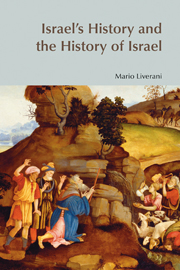Book contents
- Frontmatter
- Dedication
- Contents
- List of Tables and Illustrations
- Foreword
- Abbreviations
- IMPRINTING
- Part I A NORMAL HISTORY
- INTERMEZZO
- Part II AN INVENTED HISTORY
- Chapter 13 RETURNEES AND ‘REMAINEES’: THE INVENTION OF THE PATRIARCHS
- Chapter 14 RETURNEES AND ALIENS: THE INVENTION OF THE CONQUEST
- Chapter 15 A NATION WITHOUT A KING: THE INVENTION OF THE JUDGES
- Chapter 16 THE ROYAL OPTION: THE INVENTION OF THE UNITED MONARCHY
- Chapter 17 THE PRIESTLY OPTION: THE INVENTION OF THE SOLOMONIC TEMPLE
- Chapter 18 SELF-IDENTIFICATION: THE INVENTION OF THE LAW
- EPILOGUE
- Bibliography
- Index of References
- Index of Names of Persons and Deities
- Index of Placenames
Chapter 16 - THE ROYAL OPTION: THE INVENTION OF THE UNITED MONARCHY
from Part II - AN INVENTED HISTORY
- Frontmatter
- Dedication
- Contents
- List of Tables and Illustrations
- Foreword
- Abbreviations
- IMPRINTING
- Part I A NORMAL HISTORY
- INTERMEZZO
- Part II AN INVENTED HISTORY
- Chapter 13 RETURNEES AND ‘REMAINEES’: THE INVENTION OF THE PATRIARCHS
- Chapter 14 RETURNEES AND ALIENS: THE INVENTION OF THE CONQUEST
- Chapter 15 A NATION WITHOUT A KING: THE INVENTION OF THE JUDGES
- Chapter 16 THE ROYAL OPTION: THE INVENTION OF THE UNITED MONARCHY
- Chapter 17 THE PRIESTLY OPTION: THE INVENTION OF THE SOLOMONIC TEMPLE
- Chapter 18 SELF-IDENTIFICATION: THE INVENTION OF THE LAW
- EPILOGUE
- Bibliography
- Index of References
- Index of Names of Persons and Deities
- Index of Placenames
Summary
The Dying Rays of the House of David
The monarchy, personified in the last descendants of the ‘house of David’, remained the foundation of hopes for redemption throughout the sixth century. This was initially a predictable option, so deeply rooted was the identification between the royal house and national independence. The plan to rebuild Israel, in its old territory, and in the same manner as before, could only imagine putting the legitimate king back on the throne (Jehoiachin, or after his death, his legitimate heir). The monarchic option, however, encountered both ideological and practical opposition. Ideologically, the negative verdict on past experience could only weigh heavily, and did so increasingly as the idea developed that national disaster was of course to be blamed on all the citizens, but above all on its monarchs. Compare the assessment of the ‘house of David's’ failure later expressed by Third Isaiah (Isaiah 56–59) with the trust still displayed by First Isaiah. If hope for redemption was to be based on greater loyalty to Yahweh, not only a ‘new covenant’, but also a new kingship must be conceived, not repeating the mistakes of the past, just (assured by a more important role for the people's representatives), and pious (assured by a political role for the priesthood).
- Type
- Chapter
- Information
- Israel's History and the History of Israel , pp. 308 - 323Publisher: Acumen PublishingPrint publication year: 2005



